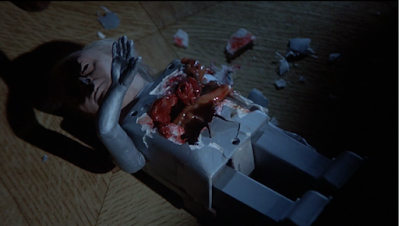Marine atomic tests cause changes in the ocean's ecosystem resulting in dangerous blobs of radiation and the resurrection of a dormant dinosaur that threatens London
The Giant Behemoth (a.k.a. Behemoth the Sea Monster in the U.K. and The Behemoth) is a 1959 black-and-white science fiction giant monster film distributed by Allied Artists Pictures. The film was produced by Ted Lloyd, directed by Eugène Lourié, and stars Gene Evans and André Morell. The screenplay was written by blacklisted author Daniel Lewis James (under the name "Daniel Hyatt") with director Lourié.
The Giant Behemoth was one of the last giant monster-on-the-loose films of the 1950's, And this amazing beast doesn't fucking show up until 50 minutes into a 79 minute film. The story itself isn't horrible but god damn in a giant monster movie let's have a little more giant monster.
The Biggest Thing Since Time Began!
It was King Kong's Willis O'Brien and his assistant Pete Peterson, that brought the Behemoth to life. This was basically a copy of the Beast From 20,000 Fathoms and not nearly as good. The original script for this film was about an invisible radioactive monster that dwelled in the ocean. The backers of this film turned the script down, saying they didn't like the idea of an invisible monster. Who in the blue hell thought it was a good idea to have an invisible monster?
For the most part, the actors do a credible job although Gene Evans (Dr. Karnes) overplays his part a bit. "The Giant Behemoth" isn't bad, but it's basically a rehash of a plot that had already been done - and done better. Good, but not great, for this type of thing.
SEE the Beast that shakes the Earth! LIVE in a world gone mad! WATCH the chaos of a smashed civilization! FLEE from the mightiest fright on the screen! NOTHING so Big as Behemoth!
Trivia:
Willis H. O'Brien and Pete Peterson completed a significant amount of the stop-motion animation on a table in Peterson's garage.
The original stop-motion puppet of the Behemoth is owned by Dennis Muren.
Many of the sound effects are taken from King Kong (1933), including Fay Wray's scream.
US prints do not have Douglas Hickox sharing the directing credit with Eugène Lourié, nor list Leonard Sachs among the cast. The UK version's credits, on the other hand, leave off the entire special effects crew.
There are lots of The Beatles connections in this movie. Jessie Robins (as Jessie Robbins), who played Aunt Jessie in Magical Mystery Tour (1967), is in a scene drinking tea whilst the radio reports are airing. Norman Rossington, who played Norm in A Hard Day's Night (1964), is one of the men killed in the car when the Beast tosses it into the Thames. Lastly, in the scenes showing a deserted London, in one of the streets is the block of flats The Beatles live in at the start of Help! (1965).
To save money on an already tiny budget,the attacks on London and the ferry were filmed without sound. Many people are seen talking but there is no dialog. Sound effects were added later. The reporter at the ministry is shown in close up, but his mouth movements and dialog don't match. He also has a distinct American accent.
The helicopters in the movie are a US H-5 Dragonfly and an H-19 with RAF markings.
Several clips from the film were used in Knots Landing: Giganticus II: The Revenge (1989), Knots Landing: Dial M for Modem (1989) and Knots Landing: That's What Friends Are For (1989) to represent the fictional Japanese kaiju film "Giganticus".
Unlike his contemporaries, the Rhedosaurus (from The Beast from 20,000 Fathoms (1953)) and the eponymous monster of Godzilla (1954), who both walk on the ocean floor, Behemoth is seen swimming under water in the Thames. However, to save money on animation, only his back legs move; his forelegs are stationary.
In the original story treatment, the Behemoth was originally going to be an amorphous radioactive blob, but the producers wanted a dinosaur creature similar to the Rhedosaurus from The Beast from 20,000 Fathoms (1953). Eugène Lourié, the director of that film, directed this one, as well as assisting on the screenplay.
The audio commentary by Phil Tippett and Dennis Muren on the film's DVD and Blu-ray release generated some ire among enthusiasts of Willis H. O'Brien. Many found the comments by Tippett and Muren to be condescending and misinformed as the pair lambasted the film and didn't offer much information with many of their statements ending with "I don't know".


















































